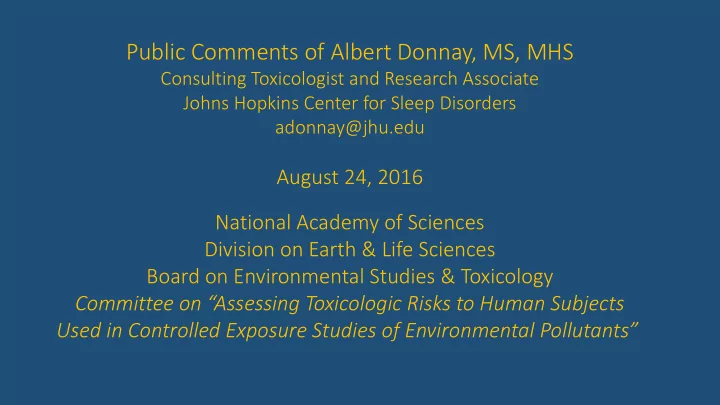

Public Comments of Albert Donnay, MS, MHS Consulting Toxicologist and Research Associate Johns Hopkins Center for Sleep Disorders adonnay@jhu.edu August 24, 2016 National Academy of Sciences Division on Earth & Life Sciences Board on Environmental Studies & Toxicology Committee on “Assessing Toxicologic Risks to Human Subjects Used in Controlled Exposure Studies of Environmental Pollutants”
His istory ry of f EPA reli liance on Controll lled Human In Inhalation Exposure Studies (C (CHIEs) for Settin ing National l Ambient Air ir Quali lity Standards Carbon Monoxide NAAQS is the only NAAQS ... * based exclusively on the results of CHIEs * that has not changed since adopted in 1971, though its basis has: 1971 : based on vision changes reported in 1 CHIEs (later found irreproducible) 1980 : proposed basing on cardiac changes reported in 8 CHIEs by Aronow et al 1985 : changed basis to cardiac changes reported in 1 CHIEs by EPA staff with n=10 1994 : kept same basis as 1985, citing 3 more cardiac CHIEs (2 EPA $ and 1 CARB $) 2011 : kept same basis as 1994, citing 1 more cardiac CHIEs from 1998 (CARB $)
Table 1 CHIE IE St Studies cit ited by EPA in in 2011 as basis for r CO NAAQS CO CHIE Studies Funding Source(s) Reported number of fully tested subjects all with ischemic heart disease and stable angina * authors include (plus number of dropouts if known) ≥ 1 EPA staff Adams* 1988 EPA intramural and 30 men extramural with UNC (plus 12 dropouts) Anderson* 1973 EPA intramural 10 men, 5 of them smokers (no dropouts mentioned) Allred 1989a,b, 1991 EPA extramural 63 men commissioned from (plus 7 dropouts, 6 cut, and Health Effects Institute 31 not reported) Kleinman 1989 CARB extramural and 24 men Southern Occupational (plus 2 dropouts) Health Center intramural Kleinman 1998 CARB extramural and 17 men, 15 of them ex-smokers Southern Occupational (no dropouts mentioned) Health Center intramural Sheps* 1987 EPA intramural and 25 men and 5 women extramural with UNC (no dropouts mentioned)
Table 2 CO Exposures Used in in St Studies cit ited by EPA Administrator in in 20 2011 CO CHIE Studies CO Exposure Level, Duration and vCOHb Target, if any * authors include Note 1: All exposures exceeded EPA 1-hour NAAQS of 35ppm ≥ 1 EPA staff Note 2: None of the studies that varied individual exposure times to reach COHb targets reported the mean, range or SD time Inhaled 100ppm (n=17) or 200ppm (n=13), both for ≥ 1 hour on one day, Adams* 1988 varying extra time to reach 6% venous COHb Inhaled 50 and 100ppm for 4 hours each on two days Anderson* 1973 Inhaled 150ppm for 1 hour on 1 st day; Allred 1989a,b, 1991 2 nd and 3 rd days varied from 42 to 357 ppm and from 50-70 minutes, varying time to reach targets of 2.2% and 4.4% venous COHb Inhaled 100ppm for 1 hour on one day to reach mean 3.0% venous COHb Kleinman 1989 without varying individual times Inhaled 100ppm for ≥ 2 hours each on two days, Kleinman 1998 varying extra time to reach target of 4% venous COHb Inhaled 100ppm for ≥ 1 hour on one day, Sheps* 1987 varying extra time to reach target of 4% venous COHb
Allr llred et al l CO Dose-Response Data x-axis = = CO O dos oses in in ppm*minutes y-axis = = prim rimary ad adver erse ou outcomes In Figure C1 at left, y y = % change in time to abnormal ST-EKG during exercise post vs pre-exposure In Figure C2 at right, y y = = % change in time to onset of angina during same exercise Source: Figures C1 and C2 above are from Allred 1989, HEI Research Report #25 Replotted below by Donnay showing low CO range in green and hi CO in red with flat or falling regression lines
In Inconsistent correlation betw tween venous COHb as measured by IL IL 282 CO-oximeter (x (x) ) compared to Gold ld Standard Gas Chromatograph (y (y) 5 of 6 CHIE studies used IL 282s 4 of 6 relied on Allred’s QC lab to calibrate their IL282s by this GC method Data from Allred 1989 HEI version Appendix B; Figure by Donnay
Conclu lusions EPA use of CHIE studies in setting National Ambient Air Quality Standards 1. Is inherently unrepresentative and under-powered vs epi studies 2. Violates the Common Rule and other ethical standards 3. Inappropriately focuses on brief indoor exposures above NAAQS in place of chronic low exposures outdoors below NAAQS NAS/DELS/BEST Commit ittee should recommend th that EPA stop conducting, fu funding and cit iting CHIE stu tudies for use in in NAAQS rule lemakings and focus in instead on epi i stu tudies
Recommend
More recommend